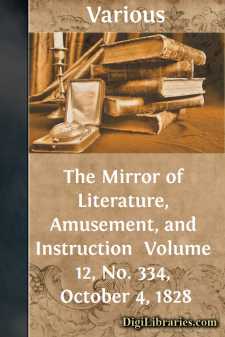Categories
- Antiques & Collectibles 13
- Architecture 36
- Art 48
- Bibles 22
- Biography & Autobiography 813
- Body, Mind & Spirit 142
- Business & Economics 28
- Children's Books 17
- Children's Fiction 14
- Computers 4
- Cooking 94
- Crafts & Hobbies 4
- Drama 346
- Education 46
- Family & Relationships 57
- Fiction 11829
- Games 19
- Gardening 17
- Health & Fitness 34
- History 1377
- House & Home 1
- Humor 147
- Juvenile Fiction 1873
- Juvenile Nonfiction 202
- Language Arts & Disciplines 88
- Law 16
- Literary Collections 686
- Literary Criticism 179
- Mathematics 13
- Medical 41
- Music 40
- Nature 179
- Non-Classifiable 1768
- Performing Arts 7
- Periodicals 1453
- Philosophy 64
- Photography 2
- Poetry 896
- Political Science 203
- Psychology 42
- Reference 154
- Religion 513
- Science 126
- Self-Help 84
- Social Science 81
- Sports & Recreation 34
- Study Aids 3
- Technology & Engineering 59
- Transportation 23
- Travel 463
- True Crime 29
The Mirror of Literature, Amusement, and Instruction Volume 12, No. 334, October 4, 1828
by: Various
Categories:
Description:
Excerpt
UNITED SERVICE CLUB-HOUSE
Modern club-houses are, for the most part, splendid specimens of the style which luxury and good-living have attained in this country. Such are their internal recommendations; but to the public they are interesting for the architectural embellishment which they add to the streets of the metropolis. If we reason on Bishop Berkeley's theory—that all the mansions, equipages, &c. we see abroad, are intended for our gratification—we must soon forget the turtle, venison, and claret that are stored in the larders and cellars of club-houses, whilst our admiration is awakened at the taste which is lavished on their exteriors.
The "United Service" Club-House is, as its name implies, intended for the Officers of the Army and Navy, who, in these pacific times, may here enjoy otium cum dignitate, and fill up the intervals of refection, in reading the "history of the war," from the noble quarto to the last dispatches received at the Foreign Office.
The above Club-House, which occupies an angle of Charles-street and Regent-street, is, however, but a meagre specimen of the abilities of the architect, Mr. Smirke. It has none of the characteristic decorations of either service, if we except the bas-relief on the entrance-front in Charles street, which represents Britannia distributing laurels to her brave sons by land and sea. The architecture of the whole is cold and unfeeling, and even the columns supporting the porticoes are of a very rigid order—when we consider that the clubhouse is not an official establishment, but one intended for luxurious accommodation, and that it would have admitted of much more florid embellishment. At the same time, although we quarrel with the frigidity of the exterior, we do not question the warmth of its kitchens, or the potency of its cellars; neither do we affect any knowledge of the latter—nay, not even enough to weave into a "fashionable" novel.
A new mansion is building for the United Service Club, on the site of Carlton House, under the superintendance of Mr. Nash, and which, with another new clubhouse for the Athaenaeum, will form an entrance to the new square opposite Waterloo-Place. The taste of the sword and pen does not, however, agree, and their buildings are dissimilar. In the United Service Club are two rooms of 150 feet by 50, the floors of which are constructed of cast-iron girders. At the back of these club-houses will be a large ornamental garden.
FUNERAL GARLANDS.
(For the Mirror.)
The primitive Christians censured a practice prevalent among the Romans, of decorating a corpse, previous to interment or combustion, with garlands and flowers. Their reprehension extended also to a periodical custom of placing the "first-fruits of Flora" on their graves and tombs. Thus Anchises, in Dryden's Virgil,Aeneid, book 6, says,
"Full canisters of fragrant lilies bring,
Mix'd with the purple roses of the spring;
Let me with funeral flowers his body strew—
This gift, which parents to their children owe,
This unavailing gift I may bestow."
Notwithstanding the anathemas of the church, these simple, interesting, and harmless (if not laudable) practices still remain....












